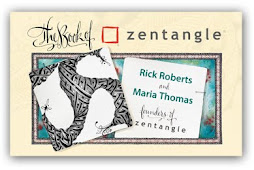In this morning's websurf, I landed on, Why You Learn More Effectively by Writing Than Typing.
The act of writing helps you clarify your thoughts, remember things better, and reach your goals more surely. Here's a look at the science and psychology behind writing, and why the pen may be mightier than the keyboard.Zentangle is all about putting pen to paper, so I wanted to read this. I encourage you to read it, too.
Today there are fewer and fewer reasons to put pen to paper. So when you do put pen to paper, it has a greater impact. Putting pen to paper creates an intimate closed loop as your eyes focus on your pen and its ink. This experience is primal and immediate.
In other systems that loop is broken. If your fingers are on a keyboard, mouse or tablet, your eyes are usually on a screen. If you're watching your fingers type (even on a typewriter), the result is also elsewhere. Even if you are using a stylus on a touch screen there is a technical gap between stylus and screen image. As your movements are translated through computer processors and software into pixels on your display, your stylus never really "touches" your creation.
My takeaway from this article (not surprisingly) is that the magic of writing longhand is in what happens because you put pen to paper, not just because you are writing.
This article reinforces how valuable the practice of Zentangle's method is. The benefits of putting pen to paper don't depend on how good you are, they depend on doing it. Zentangle's method provides the structure and freedom for you to enjoy this process without expectations or self-criticism. I think that's an important and easily overlooked reason for the benefits and enjoyment that Zentangle provides.
As you enjoy creating something in a Zentangle way, fresh and creative ideas have a way of popping up. Keep another sheet of paper handy to capture those idea jewels!
-----+-----
Click image for larger view.






5 comments:
This is a great argument for calligraphy, contemplative journaling and, of course, Zentangle. When we were learning Sanskrit, my wife and I were amazed at how meditative and holistic the process of simply writing the Devanagari characters was, and Zentangle is no less rewarding.
But as a wordsmith I also want to praise the computer as a creative tool. As a creative writing major in the 60's, I went through the pen-to-paper-to-typrwriter process for 4 years, plus 3 years of grad school. The computer gives me a much more flexible means of arranging and rearranging thoughts and words, and allows a much less interrupted flow.
The meditative aspect of pen-to-paper is much more effective at helping us to transcend thought, but my computer is still my office. A Puerto Rican friend once told me, "I write in English when I want to express my thoughts; I write in Spanish when I want to express my heart." Perhaps there is a similar relationship between computer and quill.
This makes so much sense to me. I'm a visual learner so when I need to pay close attention to something or really learn something, I print it off (if it's on computer) and I read and write notes in the margins. When I was at uni I was one of few without a laptop too because I knew if I hand wrote dot points I would recall things more accurately.
And as a CZT I can absolutely vouch that the process of Zentangle and it's pen to paper approach is ABSOLUTELY brilliant in assisting learning and retaining information!
Hi Savitr,
In CZT training, we discuss Zentangle's value in "contemplative journaling."
My experience is that when I revisit a journal entry I wrote about an emotionally charged event, my language tends to "draw" me back into whatever perspective I had when I was writing.
When I revisit a Zentangle tile that I created around an emotionally charged event, two things are different from reading a journal entry.
First, I see the whole Zentangle tile all at once (compared with reading through lines of text) and I immediately feel where I was, what the weather was like, etc.
Second, I am more likely to re-interpret (or "recapitulate") my entry because, not only is it less literal, but I can rotate my tile and notice aspects I put into it that I hadn't noticed before.
With best (computer loving because if for no other reason we can have these conversations) regards,
Rick
P.S.
Hi, Kass!
Hello, I am a newbie with the Zentangle but have so enjoyed the nine I have done since a friend introduced me to the process a couple of weeks ago. I am taking a class from a CZT instructor on Jan. 8 and am really looking forward to it. I think already that ZT practice will improve my drawing skills for my other paintings. See my Paint Party Friday entry today to see my holiday themed tangle.
Rick, this is no doubt one of the advantages of journal writing (by hand) and morning pages (Julia Cameron).
Gloria, I like the strings of candles! After I became a CZT I realized that I had been missing an important aspect of zentangle creation; seeing your tile I wonder if you're in the same position. It will be interesting to see what you do after your class with a CZT! It will be fun!
Post a Comment